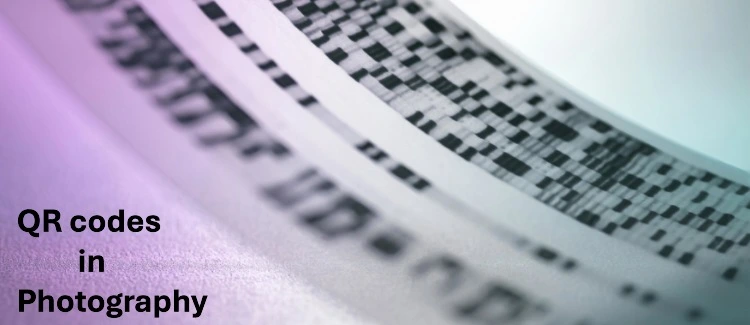Theodore Lowe, Ap #867-859
Sit Rd, Azusa New York
Find us here
26 Tips for Outstanding Wedding Photography
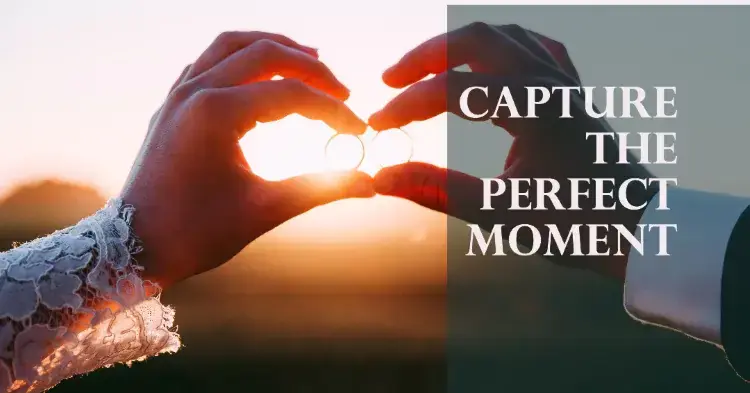
Weddings are once-in-a-lifetime events for every Couple, and taking responsibility for capturing these precious memories is a difficult and stressful task. Though social trends may vary over time, the basic rituals will be the same for every different culture. The wedding photographer's job is to take pictures of the bride and groom as they celebrate their special day by following their cultural traditions.
You don't get second chances at weddings; they're an important event. You must be well-prepared, well-organized, and knowledgeable!
Here are 26 professional tips to capture stunning images that will be treasured forever by the wedding couple.
Wedding photography tips
1. Signing a contract
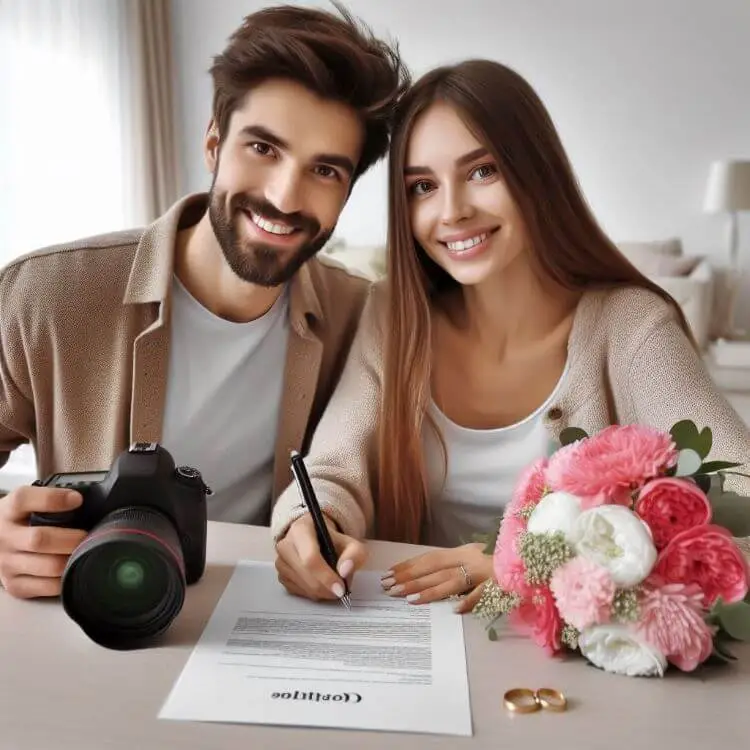
You must have your client sign a contract with you as this will be proof of documentation for both the client and photographer. This contract will be drafted depending on customer needs and the terms of payment agreed with the photographer after multiple meetings with the client.
This contract will also include all the roles and responsibilities of the photographer. The time frame will also be mentioned here to clarify how long they will stay in the event, how many edited photos they will provide, and how many printed copies they will provide and at what sizes.
The liabilities of the photographer will be mentioned in the agreement. Only if the client agrees will they sign the contract. It also keeps both parties safer as none of them can cancel the agreement suddenly.
2. Understand the goals of the couple
Having a thorough discussion with the Couple before their big day will help you understand their expectations and priorities. This way, you can deliver photos that match their vibe and resonate with them. Moreover, you should know the story that brought them together.
Feeling a sense of care and responsibility will naturally arise, making you more alert and focused on your task. As a result, you will capture the best photos and create an effortless wedding photo album.
3. Study about the venue
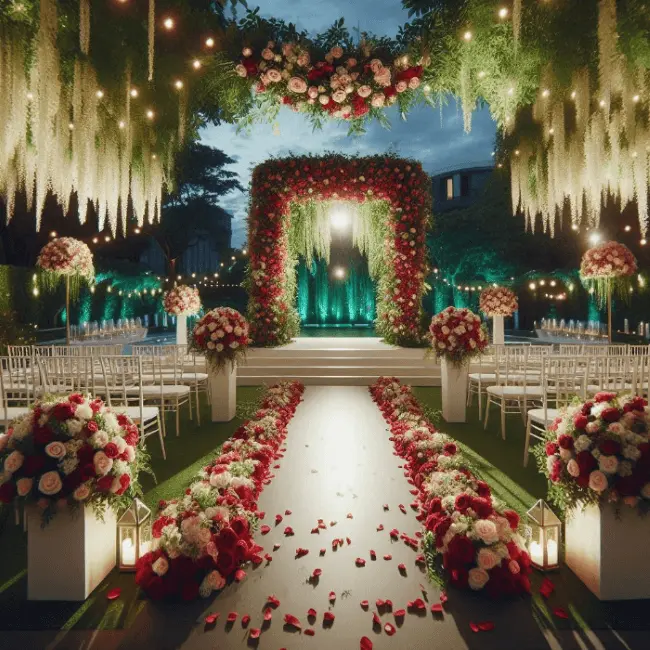
Visit the wedding venue before the event date to get familiar with the lighting and potential photo spots. If an in-person visit is difficult, then you must check as many images as possible of the location from the web. Learn about all the possibilities available in the location for both outdoor and indoor photoshoots.
While indoor shots give darker lighting and a specific set-up, outdoor shoots offer stunning backgrounds and natural sunlight. To ensure the best lighting and comfort for an outdoor shot, take into consideration the time of day and weather. For indoor picture sessions, think about including attractive architectural details.
Moreover, destination weddings offer endless creative options as various locations offer breathtaking photo opportunities, from mountains covered in snow to tropical beaches. Knowing the venue well will help you plan the shots and overcome any challenges that might arise.
4. Create a shot list
Memorize the shot list you plan for the event after studying the location, as you have to cover it all before the day ends. While going with the flow and being present in the moment is great. Yet having a shot list can ensure you capture all the special memories and locations at the event.
At the beginning of the event, the Couple and their family will be busy fixing their hair and makeup. During that time, you can take close-up shots of the wedding rings, bride's veil, stage decoration, flower arrangements, dresses, shoes, jewelry, and other accessories worn by the bride, groom, and wedding guests. Plan about all the must-have shots to cover throughout the day.
5. Capture the first look
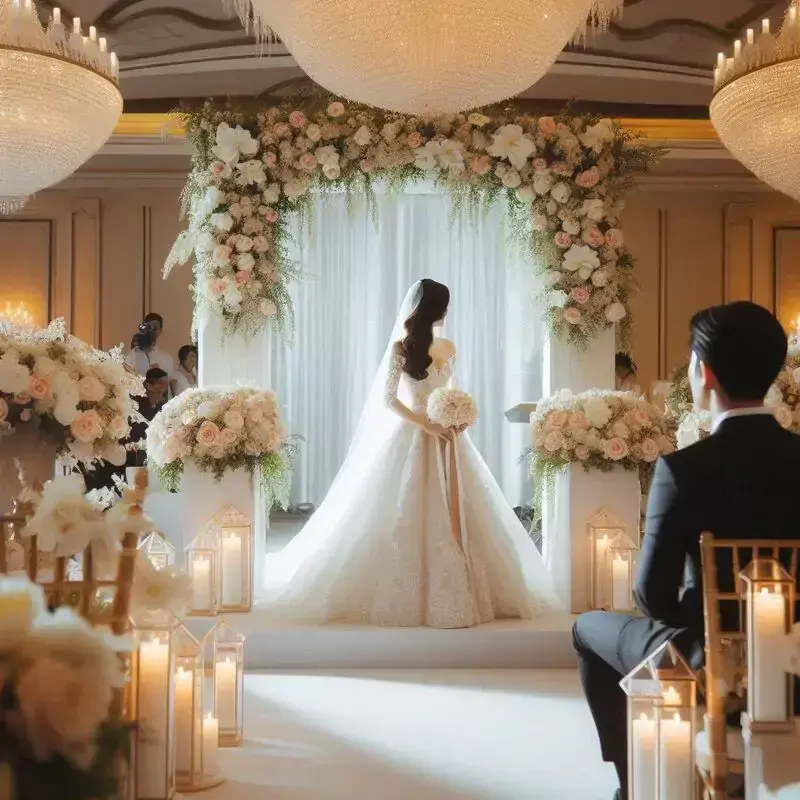
The Couple's first look is a special and emotional occasion that should be perfectly captured. Secretly place yourself to get real emotions without disturbing the flow of the moment. A special entry for the bride is highly trending nowadays. The first kissing moment is also as important as the first entry, so you must capture all these experiences.
6. Photography tips for bride

A bride's look usually includes many accessories like bracelets, earrings, and necklaces, along with the dress, shoes, and rings. You must click pictures of each of them. You can also click candid pictures when the bridesmaids are fixing the bride's hair and makeup.
Also, make sure to take pictures showing how close the bride is to her parents. Capture moments like the bride hugging or crying with her father and mother. Take artistic pictures of the bride in the most striking areas of the location, like by a grand window or on a staircase.
7. Photography tips for the groom

Make sure you have enough time and creative energy to tell the groom's side of the wedding day tale. Though many photographers concentrate mostly on the bride only. Capture shots of the groom's outfit and other wedding items before the groom wears them.
Please take pictures of the occasion from various perspectives. Take pictures when the groom and his groomsmen get dressed to prepare great storytelling through your pictures.
You can take classic photos with the groom's smile or creative photos with different standing and sitting positions. You can even click funny photos with the groom and his groomsmen, like a say "cheers" photo with a glass of beer.

8. Capture candid moments
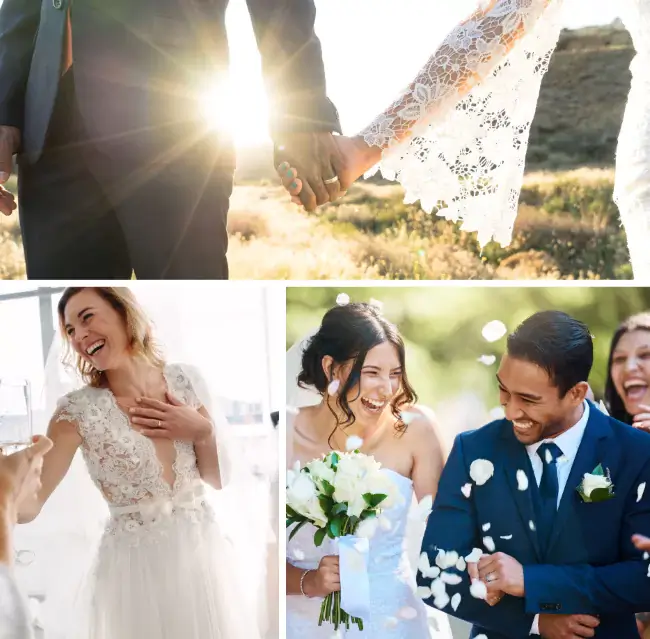
These tears, laughs, and pure blissful moments add a special and amazing touch to your client's wedding. So, tell your clients not to hesitate to enjoy themselves and let loose in front of the camera! Candid shots usually become the most memorable wedding photos.
9. Let light paint the image
As a wedding photographer, controlling light is challenging, so prepare yourself to balance with light and play with it.
Natural light: Use natural light as much as possible, even if you are getting a fraction of it through a small window. Consider requesting your clients to "look towards the light source" or "look into the sun."
Golden Hour: It includes the last hour before sunset and the first hour after sunrise. With such natural light, you will acquire photographs that are incredibly warm and lovely.
On-camera flash: If there's not enough natural light, you can compensate with a flash. By using the flash, you may illuminate the newlyweds more while removing the darkest shadows. Determine whether there are any unique rules regarding the use of flash at the venue.
Reflectors: Reflectors redirect light into the scene. For example, if the sunlight is behind the newlyweds, you can place a reflector in front of them. This can create a stunning background by redirecting some of the light.
10. Learn night-time photography
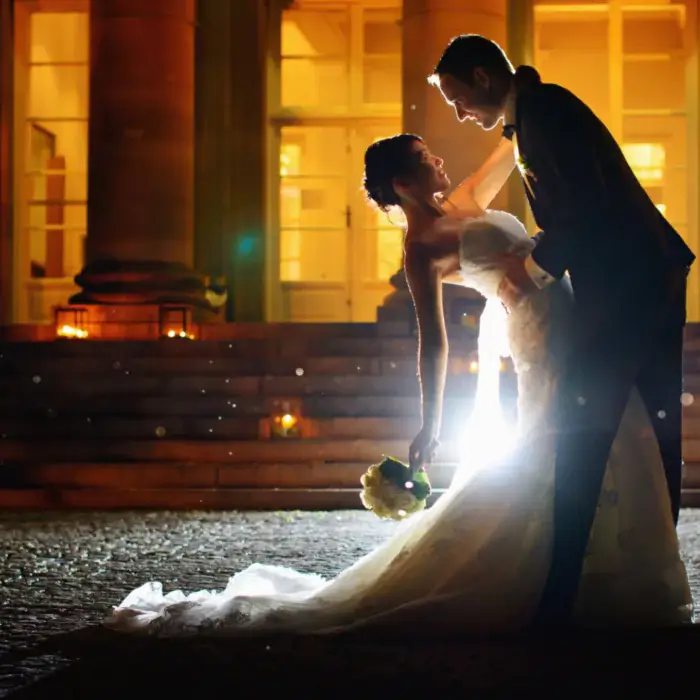
The beauty of photos captured at night is Undoubtedly the best to daytime photos. The lighting set-up will vary depending on the type of shot you want to capture.
At times, you may use the backlighting only to click a creative, stylish photo. Sometimes, you may use both the backlighting and front light. Night-time photos are more romantic, so it is best to take closed poses with or without a kiss.
11. Shoot in RAW format
A lot of amateur photographers believe that because RAW requires more processing, shooting in RAW is time-consuming. But if you're serious about catching stunning wedding moments, you need to commit to work in RAW. You have more control over the post-processing process if you shoot in RAW format. You may adjust white balance, exposure, and other settings without compromising the quality of your images.
12. Use of props to enhance your photos
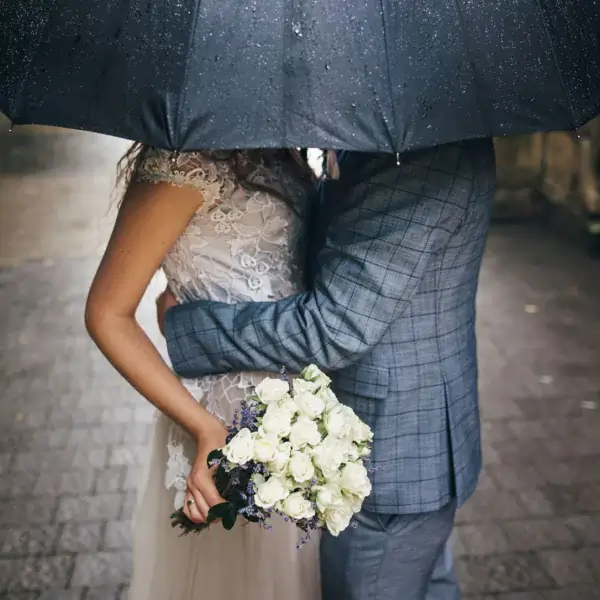
Props like a fancy umbrella, vintage car, bouquet of balloons, or flowers can make wedding photos more playful and unique.
13. Don't forget the Details
Take pictures of the little details that add to the overall story of the day. It includes candid expressions, laughter, tears, and all the little moments while the wedding ceremony is going on. Be present at the moment and continue capturing the magic as it unfolds. Also, take pictures of the decor, stage, and flower arrangements.
14. Photos with closest friends and family
Remember to take snaps with your closest friends and family who made your special day memorable. These family photos will remind you of all the love and support you received on your special day, from funny poses to emotional hugs.
15. Take a grand group shot
No photographer should miss this group shot. This would be a grand picture of everyone who was part of this wedding. First, find a point high above the crowd from which you can click this shot. Then, bring the bride and groom to that specific area and embrace all the other guests there to take this large group shot.
16. Learn symmetrical group posing
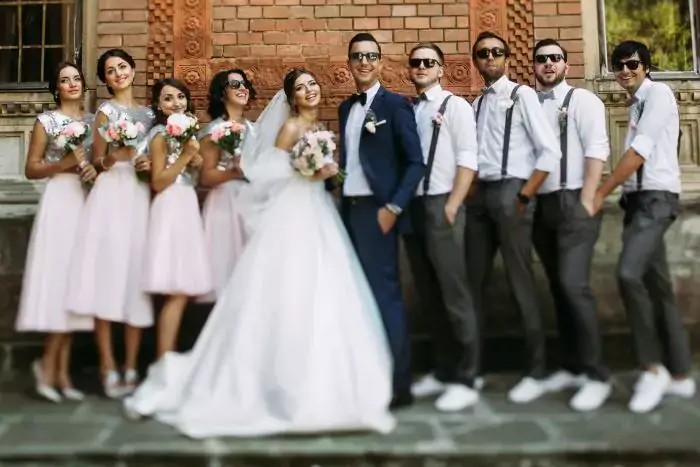
Symmetrical posing is great for small groups of 5 or 6 or even for larger groups of 20 or more. In this pose, make sure you place the bride and groom in the center and watch for height balance across the group. You also have to balance the number of subjects on each side.
17. Black and White photography
When captured in black and white, wedding images can be timelessly elegant. Try different single-tone arrangements to produce noticeable, stunning pictures.
18. Shut down the sound on your camera
The sound of your camera's beeps can be annoying during marriage rituals like speeches and vows. They are also a distraction for all the guests. Hence, you must turn off the camera sounds before going to an event. Some mirrorless models have the powerful capability to shoot silently.
19. Wedding photography cameras
To photograph a wedding, you will need a full-frame sensor camera, which can perform better in low light. It would help if you also hava a camera with an exchangeable lens system.
The two primary options available now in the market are DSLR or mirrorless systems. Mirrorlesses are better for wedding photography than DSLR systems because of their light and compact size. If you are an amateur, you can start with a DSLR you can afford. You can upgrade accordingly based on your experience and income.
The ideal camera for wedding photography could be a Nikon D850, Canon EOS R5, or Sony ALPHA A1. There are a variety of camera options available for wedding photography. If these are out of your price range, you can buy a used one or an older version of them.
20. Use multiple lenses
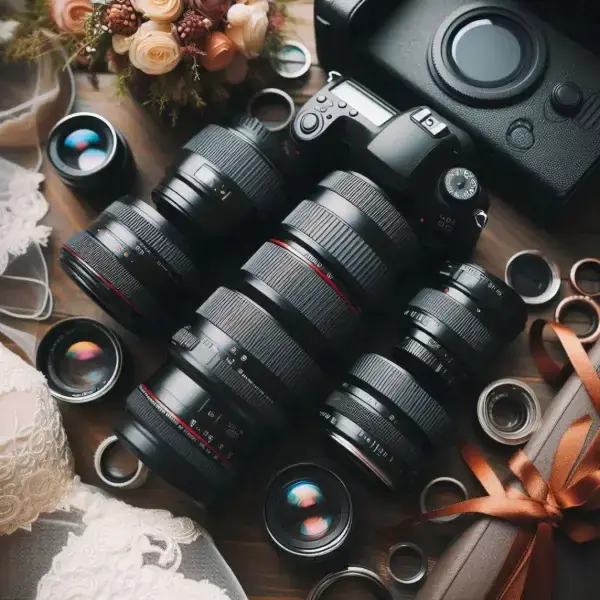
The ideal lenses for wedding photography are fast lenses with drops down to a low aperture number. Most wedding photographers have a versatile focal length of 24-70mm standard zoom, which is a lifesaver to shoot in a tight space.
70-200mm telephoto zoom is best for portrait pictures. For candid shots, a 50mm wide-aperture prime is a better lens. Meanwhile, 16-35mm wide zoom is best for group shots including all the guests. For closer detail, shots like the picture of a wedding finger ring require a 100mm macro lens
21. Use two cameras
Having two cameras can make you a more versatile photographer. It also gives you a backup if your primary camera breaks down. This is a common practice for professional wedding photographers to use two or more cameras. You should follow this habit.
22. Use continuous shooting mode
Capturing all the key moments is vital in any wedding event. Hence, using a continuous shooting mode is a must to capture a series of shots progressing rapidly.
Different cameras have different continuous shooting rates. Therefore, it is worthwhile to invest in a camera that can capture at least 5–10 frames per second. This will guarantee that you can precisely capture those ephemeral moments in time.
23. Take an extra battery and memory card
You might need more space on your SD cards or have your battery fail, so always keep several SD cards and at least two batteries. Continuous shooting mode consumes a lot of space on the camera. Therefore, you must carry multiple memory cards to avoid missing any moment of the wedding.
24. Experiment at different angles

Try taking pictures from different positions. Hold the camera high in the air for one shot, then lower it to your waist or even your ankles for another. This is a smart idea to use a drone or climb up on a chair to get a bird's view of the venue or capture wedding photos.
25. Have Fun and be Creative
Above all, weddings are about happiness and celebration, so remember to enjoy yourself and let your creativity flow. Experience the thrill of capturing love and happiness in their most authentic form through wedding photography. Allow your passion to radiate from your work.
26. Making use of reliable editing software
A photographer's workflow consists of two primary components: taking pictures during the wedding and editing those pictures afterward. After you've finished taking photos, you should focus on post-processing the images.
For this task, we recommend using Lightroom or Photoshop. These top-tier tools are suitable for both beginners and experienced photographers. Learn the basic editing techniques.
Edit your photos quickly.
For a professional photographer taking photos at an event and editing them by themselves afterwards can be too much work. It won't give you a lovely output, as editing your photos does the final magic to your photography. Rather, you may outsource your wedding photography pictures to a professional photo editing company like Clipping Path Associate.
Conclusion
Photography skills and imagination are necessary for storytelling to capture the romance of a wedding through photography. If you follow these 26 techniques, you will be an expert in creating lovely images that the happy Couple will treasure for a lifetime.
Don't forget to plan the event ahead of time. You must enjoy the wedding celebration while capturing the precious moments with the Happy Couple.
Related blog posts
How to Add Fonts in Photoshop: A Step-by-Step Guide
Are you ready to give your designs a unique twist? Adding new fonts in Photoshop can instantly elevate your creative projects, making them stand out with style and personality.

QR Codes in Photography: Unlocking Creative Possibilities
Imagine transforming your photography into an interactive experience that captivates your audience. QR codes are revolutionizing the way we share and engage with images.
